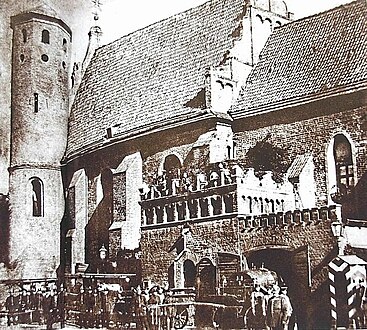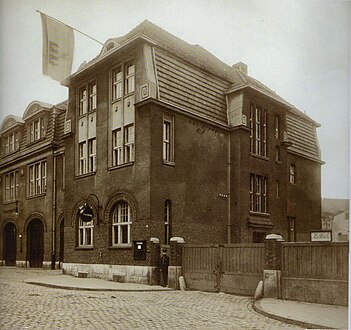
The Carl Peschel tenement is a historical habitation building in Bydgoszcz, Poland. It is registered on the Kuyavian-Pomeranian Voivodeship Heritage List.
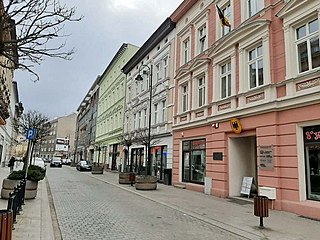
Dworcowa Street is one of the main streets of Bydgoszcz, in Downtown district. Many of its buildings are registered on Kuyavian-Pomeranian Voivodeship Heritage List.

Podwale street is a historic path of Bydgoszcz old town.
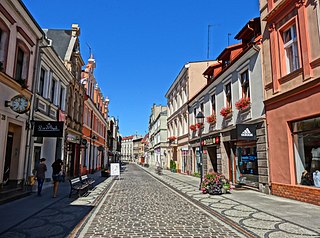
Długa Street is the longest street of Old Town district in Bydgoszcz and the most important historically. It stands next to Gdańska Street and Dworcowa Street as one of the most important avenues of downtown Bydgoszcz.

Pomorska Street is an important street in downtown Bydgoszcz.

Zygmunt Krasiński Street or Krasińskiego Street is an avenue of Bydgoszcz, in downtown district.

Gimnazjalna, Libelta and Szwalbego streets are laid in downtown district of the city of Bydgoszcz. Many of the buildings along this axis are either registered on the Kuyavian-Pomeranian Voivodeship heritage list, or part of a quaint architectural ensemble of the city.
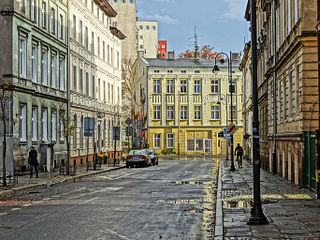
Piotra Skargi street is a historical street of downtown Bydgoszcz.

Królowej Jadwigi Street is a street located in Bydgoszcz, Poland. Many of its buildings are either registered on Kuyavian-Pomeranian Voivodeship heritage list, or part of Bydgoszcz local history.

20 Stycznia 1920 Street is located in downtown district, in Bydgoszcz, Poland. Many of the buildings along this axis are either registered on the Kuyavian-Pomeranian Voivodeship heritage list, or part of a historical ensemble of Eclectic and Art Nouveau architecture in the city.

Obrońców Bydgoszczy street is located in downtown district, in Bydgoszcz, Poland. Many of the buildings along this axis are either registered on the Kuyavian-Pomeranian Voivodeship heritage list, or part of a historical ensemble of Eclectic and Art Nouveau architecture in the city.
Anton Hoffmann was an important designer and builder in Prussian-time Bydgoszcz during the entire second half of the 19th century. He witnessed the transformation of Bydgoszcz, creating numerous residential buildings throughout the city. His activity became, in a sense, an indicator of Bydgoszcz building traditions, bridging old neo classicist masters and their successors, inspired by Historicism and Art Nouveau.

Seminaryjna street is located between Wilczak, Błonie, Downtown districts in Bydgoszcz, Poland. Laid in the late 1870s, its winding path offer a view on the old town nested down in the Brda river. Many frontages and edifices display architectural and historic interests, one of them is registered on the Kuyavian-Pomeranian Voivodeship Heritage List.

Chodkiewicza street is one of the most important arteries of Bydgoszcz centre, enabling to cross the city on an east-west axis. Many buildings along this axis undeniably carry historic importance, some are registered on the Kuyavian-Pomeranian Voivodeship Heritage list.

Maksymiliana Piotrowskiego Street is a street of Bydgoszcz centre, in the vicinity of several city highlights. Many buildings along this path carry historical interest.

Chrobrego Street is an avenue located in downtown Bydgoszcz. Its frontage carries tenements which present a character of uniformity in their architectural features, several of them being listed at the Kuyavian-Pomeranian Voivodeship heritage list.
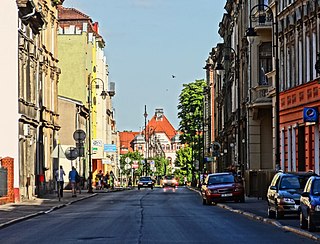
Świętojańska Street is an historical avenue in downtown Bydgoszcz. Its frontages display various architectural features. A couple of them are listed on the Kuyavian-Pomeranian Voivodeship heritage list.

New Market Square is a city square located in downtown Bydgoszcz, Poland. Dating from the early 19th century, it has been remodelled since its creation.

Kwiatowa street is a short pathway in downtown Bydgoszcz, presenting several architectural buildings erected during a period stretching from the end of the 19th century to the 1930s.

Bocianowo Street is a 600 metres (2,000 ft) long path in the northern part of Bydgoszcz city. Its facades display various architectural styles and its history sticks with the end-of-19th-century development of the town.



